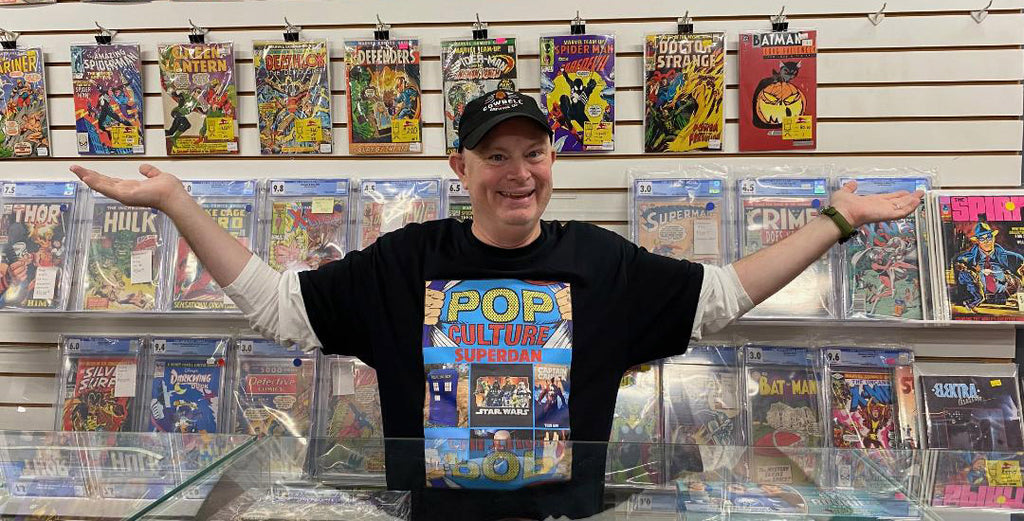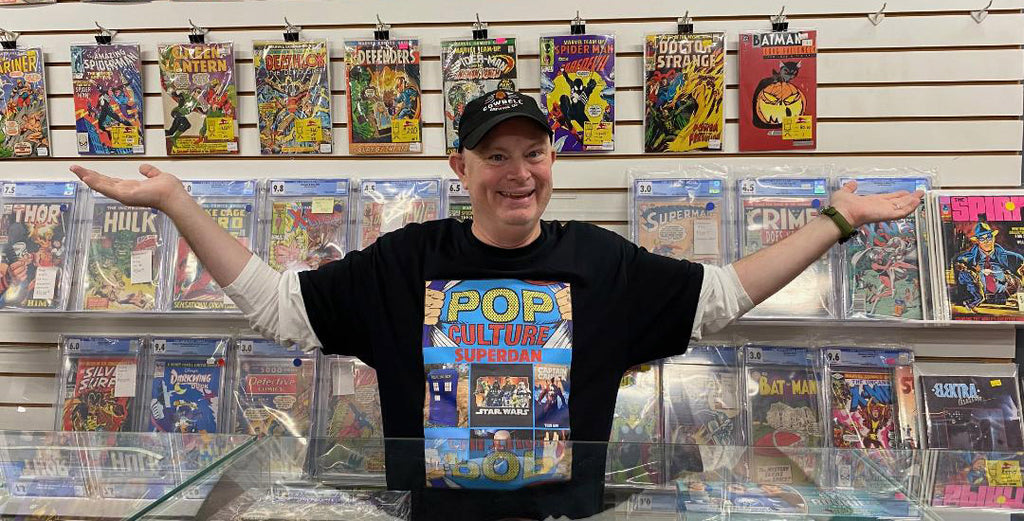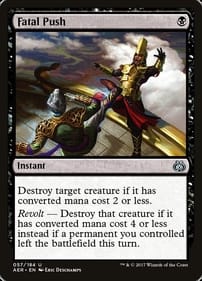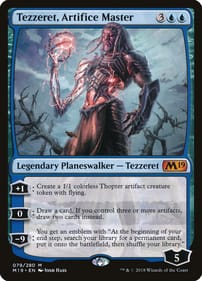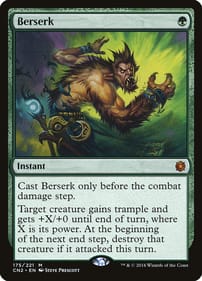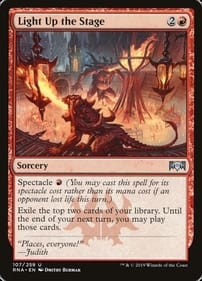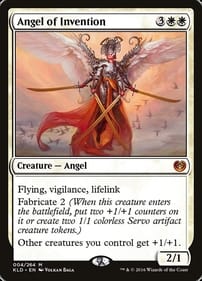What I read on my Christmas break
By Dan Brown I’m one of the lucky ones who got some days off at Christmas. It won’t surprise you to learn I spent much of my time away from work reading graphic novels. Here’s the rundown on the books I finished while going through my TBR pile. Ginseng Roots by Craig Thompson: You may know Thompson as the American comic creator behind the landmark book Blankets, in which he chronicled his turning away from religion as a teen. In this new volume, published last year, he again covers his youth, but this time he uses his childhood jobs on Wisconsin farms as the launching point for telling the story of ginseng. I will be honest with you, I wondered how the writer/artist would be able to fill 448 pages with details about a single plant. That didn’t sound like a workable premise to me. Surprisingly, he pulls it off wonderfully. I found the thick graphic novel engrossing. His lines are lush and this is the kind of book that reviewers call “expansive.” His scope is wide – really, it’s not about farming, it’s about life. Thompson is clearly at the peak of his storytelling powers. Drinking at the Movies by Julia Wertz: New York cartoonist Wertz relates how she came to live in the Big Apple after leaving her childhood home in San Francisco. Her autobiographical mini-stories revolve around Wertz’s struggle to understand her own motivations as she enters young adulthood. If Mimi Pond is among the comic creators you enjoy, you should check this one out. Based on this collection of Wertz’s strips, I plan to read more of her comics. Various by Jeff Lemire: I’ve been meaning to do a deep dive on the Southwestern Ontario creator, and finally got a chance over the holidays. I read stuff he wrote and drew himself (Fishflies, Minor Arcana Volume One) as well as titles on which he wrote and collaborated with another artist (Plutona, Primordial, Phantom Road Volume One). I would say the highlights for me were Plutona and Phantom Road. The former is about a group of school kids finding the body of a superhero (shades of the movie Stand By Me), the latter about a long-haul trucker who is transported to an alternate dimension where zombie-type monsters roam the landscape. As always, I don’t recommend Lemire for those who want pat explanations like you might get in a mainstream Marvel or DC comic. He likes to keep things mysterious for his readers. Ashes by Alvaro Ortiz: This thin volume is akin to a road movie in which a group of friends reunites after many years to carry out the wishes of a departed buddy who has been cremated. It has a fairy-tale quality to it, and I enjoyed the sweet ending. DC: The New Frontier by Darwyn Cooke: This Compact Edition, featuring almost all of DC’s roster , didn’t move the needle for me. I think that’s because I don’t know enough about the DC universe to understand the significance of how its heroes behave here. It seemed derivative of previous comics, such as Frank Miller’s Dark Knight Returns, and borrowed elements from movies like 2001: A Space Odyssey. What can I say? I grew up a Marvel fan. Batman: The Long Halloween by Jeph Loeb and Tim Sale: I understand this book is much loved by DC fans. The art is evocative, and it was a cool take on the origin of Two Face. Again, I read the Compact Edition. Did you get any time to read over the holidays? Did you get any graphic novels as gifts? I would love to hear about it in the comments! Dan Brown has covered pop culture for more than 33 years as a journalist and also moderates L.A. Mood’s monthly graphic-novel group.
Merc With A Mouth Crashes Into Dark Knight’s World
By Dan Brown There’s nothing unusual about someone hiring Deadpool to carry out a contract killing. But when his latest job takes him to Gotham City, that’s when comic fans know this is no ordinary assignment. Deadpool/Batman is the latest comic-industry crossover. It shows what happens when the Merc With a Mouth (a Marvel character) crashes into the world of Batman (a DC creation). Both companies are probably hoping that by joining forces they can introduce a new generation of comic readers to the concept of industry crossovers, thus cross-pollinating different fandoms. There’s a long tradition of superhero crossovers going back to at least 1976, when Superman fought Spider-Man for the first time. Since then, they’ve become a comic fixture. (And a cultural fixture – just check out the movies like Alien vs. Predator or Freddie vs. Jason.) The story, illustrated by Greg Capullo and written by Zeb Wells, begins when Deadpool leaps through the very manor window where a bat once appeared, inspiring a young Bruce Wayne to avenge his parents by donning a batsuit. Unaware of Wayne’s secret identity, the fast-talking Deadpool explains to Wayne he has been hired to off the Dark Knight: “Some guy who dresses like a bat? Which I’m assured is grim and creepy even though that’s clearly hilarious?” (When the mutant assassin eventually comes face-to-face with the Caped Crusader, he admits he was mistaken. “Batman! You’re . .. terrifying. I hate myself for saying this, but the bat thing? It works.”) Fans of Deadpool will be happy seeing him wield a katana in each hand, and Batman devotees will be satisfied to see him brooding. It’s quite a clash of tones. In fact, those fans might find themselves questioning the book’s premise: These two don’t seem to have a lot in common, at least on the surface. Why have them become partners? Doesn’t the crazed Deadpool have more in common with someone else in the Batman pantheon . . . his nemesis, the insane Joker? Yup. Without giving too much away, the Clown Prince of Crime does make an appearance, with Deadpool labeling him a villain whose “brain is a neurospicy dopamine goblin with task paralysis and a lack of object permanence.” In other words, Deadpool and the Joker are perfect for each other. There are also backup features in this book that pair more DC heroes with Marvel protagonists. Wonder Woman teams up with Captain America, Green Arrow with Daredevil, Frank Miller’s Batman with Old Man Logan, and so on. The funniest moment among these pairings comes when Rocket Raccoon tries on Green Lantern’s ring: “Brightest day, blackest night, yada yada. Green flame on!” the genetically engineered woodland mammal cries. Considering the main story is only 25 pages long, what I would have liked to have seen is for the publishers to devote those extra 16 pages to fully fleshing out the title team-up. (There is also another crossover published at the same time as Deadpool/Batman called Batman/Deadpool, which I haven’t read yet.) With more pages, they could have expanded what is essentially an appetizer into a full-fledged meal. Also, unlike the crossovers of my childhood, the current ones are published in a regular-size comic format, so they don’t feel as special as the jumbo ones of old. Dan Brown has covered pop culture for more than 33 years as a journalist and also moderates L.A. Mood’s monthly graphic-novel group.
Sympathy for the Joker
By Dan BrownAs diehard comic fans already know, a new Joker film – the second focusing on Batman’s nemesis – arrives in theatres October 4.Call me crazy, but I don’t remember this level of interest in the Clown Prince of Crime when I was a boy falling in love with comics in the 1970s.What my buddies and I wanted was a Batman movie, not one about the Joker.And when we finally did get a big-screen version of the Dark Knight’s story in 1989, it was as much about Bats as Mr. J (and Jack Nicholson was a way bigger star than Michael Keaton).All of which is just another way of saying: Supervillains have never been as compelling as they are in 2024.We all know what heroes do: They restore order, they bind the wounded, they bring justice to the world.Villains, on the other hand, get to kick ass and take names.Would you rather be stuck in an elevator with a boring costumed do-gooder or a way-cool badass who makes his or her own rules? Who has the better theme song – Luke Skywalker or Darth Vader? Who gets all the hot girls, crossing guards or outlaw bikers?It’s true, a good guy is only admirable to the extent he can overcome the traps laid for him by the enemy, which is why you’ll see online memes asking, “Which superhero has the best rogues’ gallery?”Back in those early days as a comic lover, the answer for me was the Fantastic Four – who fought the likes of Galactus, Annihilus, and Doctor Doom. Even minor villains like Thundra were cool in their own way. But as an adult comic fan, I have to give it to Dick Tracy, whose long list of foes includes Big Boy, the Mole, the Brow, Oodles, Flyface, Measles, Hairy, No Face, Smokes, Mumbles, and Pruneface.So what changed so that villains became respectable? Somewhere along the way there was a shift in the way they were depicted; criminals went from being anti-social monsters to real people to the coolest cats around.In my lifetime, I don’t think it was a comic innovation that sparked the change in how villains are perceived. It was a movie, namely the 1972 motion picture The Godfather, with its famous portrayal of the Corleone crime family. Hard to believe, but the notion criminals were regular family men was a scandalous one at the time. I remember adults being shocked by it. It turns out baddies love their children, enjoy Sunday dinners, get frustrated at work, and do everything else the rest of us do. They aren’t insane misanthropes after all, just maybe a little misguided.The Godfather was made possible by the abolishing of Hollywood’s Production Code in 1968. No longer did filmmakers have to show crime doesn’t pay.The end result: In pop culture, the divide between good and bad shrank.Fast-forward to today (comics no longer have an industry censor, either) and what you have are criminals who are relatable. They have understandable motives. And the heroes who square off against them are morally grey – think the Watchmen, Hancock, the Boys.One of my favourite portrayals of a supervillain came in 1987’s Superman No. 2, in which comic creator John Byrne absolutely nailed one of comicdom’s great scofflaws, Lex LuthorThe premise: Luthor had commissioned the invention of a supercomputer to crack the mystery of Superman’s secret identity. With this knowledge, the bald crook intended to crush his adversary.Fully programmed, the machine spits out its answer at the end of the issue: Clark Kent is Superman. Simple, right?Yet Luthor can’t bring himself to believe a being with the powers of a god would choose to live among mere mortals as one of them. Byrne was right on the money. If Luthor was a real person, he WOULD be brilliant enough to create a device that could unmask Superman. And Luthor WOULD be arrogant enough to think he knows better. Luthor’s tragedy is that he’s sure Superman thinks the same way he does. He can’t stomach the idea of someone being able to submerge their own ego – because he’s ego-driven. It’s a failure of empathy, which is the true root of all evil.Dan Brown has covered pop culture for more than 31 years as a journalist and also moderates L.A. Mood’s monthly graphic-novel group.
Going inside the mind of Bruce Wayne
By Dan BrownBatman first appeared in 1939. Is it possible, all these decades later, there are still Batman stories left to tell?Featured in comics, big-screen serials, newspaper strips, radio dramas, live-action TV shows, animated programs, graphic novels and full-length motion pictures, the character has been through a lot.The Dark Knight has had his back broken. One of his wards has been killed in the line of duty. He’s retired, then changed his mind. His origin story has been re-told and revised and reiterated and rebooted so many times, we’ve all lost count.So what else could there possibly be?Well, there’s a crucial episode in the Caped Crusader’s life that hasn’t yet seen the light of day, and I’m going to give the idea away for free to any comic writer who wants to steal it.As we all know, unlike Superman and Wonder Woman, Batman has no special traits. Bruce Wayne is a mortal human, albeit a rich one.But according to one school of thought, he does have an ability that sets him apart from every other hero in the DC pantheon. What is Batman’s superpower? Being prepared.Combined with unlimited financial resources, the thing Wayne has going for him is he’s ready for any possibility. He has anticipated every scenario a superhero could face, and planned a solution.For example, it was in Frank Miller’s Dark Knight Returns that readers learned he was able to synthesize a small amount of kryptonite in case he ever had to face Superman in mortal combat. It took him years to accomplish, and cost a fortune, but it’s this foresight that allows Batman to put his spiked boot on Superman’s throat – and not just in a symbolic sense.In order to be prepared, one has to have a rich imagination. It’s true experience plays a part, but Bruce Wayne had to have a creative mind in the first place. After all, it’s not everyone who sees a bat fly through a window, then thinks: I’ll dress up as one of those in order to terrorize criminals.I define imagination as the ability to construct in your mind what doesn’t yet exist in the real world. It’s not just an asset to superheroes, but is the key to success in a wide range of professions. I don’t believe it’s innate. I think it can be developed. If you want a real-world example of its importance, bear in mind how the 9/11 Commission in the United States concluded it was partly a “failure of imagination” on the part of security planners that allowed the deadly attacks of that day to happen.So where does Wayne get his wonderful inventiveness? We don’t really know.Perhaps he was exposed to a lot of creativity in his younger years. In Miller’s telling, for instance, the night Wayne’s parents were killed they had just seen The Mark of Zorro at a Gotham movie theatre. Perhaps Wayne had a childhood filled with such flights of fancy.Or maybe it was Alfred who passed down his experiences to a young Wayne, opening the future crime fighter’s mind. Or perhaps there’s a character readers haven’t met yet who sparked his flowering creativity – it could have even been an influential teacher. If you grant that Batman’s superpower is being prepared, you have to account for how he developed what must be the sharpest imagination in the DC universe. That’s why, whoever it was or however it happened, the origin story of Batman’s imagination needs to be told. If you have any ideas about what other Batman stories are yet to be unleashed on comic readers, let me know in the comment box below or on Facebook.And by the way, this is the 16th column I’ve written for the website of L.A. Mood Comics & Games, but the first one I’ve written about Batman. What took me so long?Dan Brown has covered pop culture for 30 years as a journalist and also moderates L.A. Mood’s monthly graphic-novel group.




